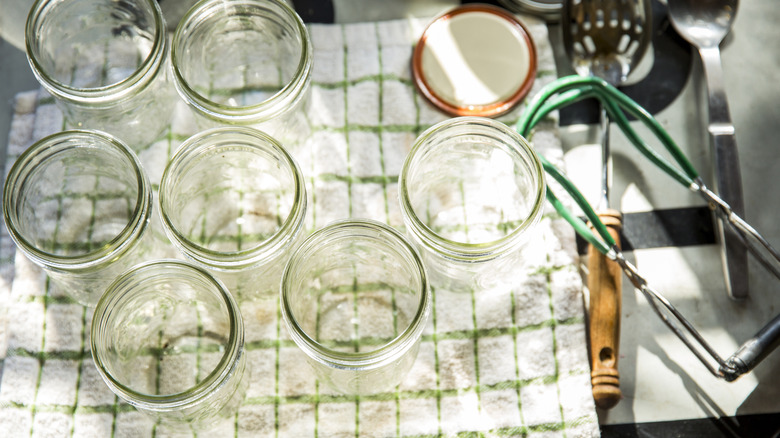The Easy Mason Jar Hack That'll Help Keep Pests Out Of Your Garden
Mason jars are used for just about everything. From starting plants to DIY bird feeders to holding seeds, there are countless handy ways to use old Mason jars in your yard and garden. If you have a stockpile of empty jars collecting dust in your cabinets or garage, put them to good use for pest control. While there is always the option of using chemicals or sprays on your plants, it's always preferable to use a natural pesticide, and Mason jars are the perfect container for one of the most popular natural pesticides to use, diatomaceous earth (DE).
This sedimentary rock is comprised of fossilized skeletons of diatoms, which are microscopic unicellular algae, and it has been utilized in pesticide products since 1960. It's highly effective against pests like aphids, ants, and slugs. Diatomaceous earth works by piercing and drying out the waxy coating that protects an insect's exoskeleton and dehydrating bugs of any fluids from the inside.
While effective, DE isn't always sold in user-friendly packages; bulk products are often in bags and pouches. Storing it in a Mason jar makes it portable as well as easy to store and use. All you need is a clean, empty Mason jar to get started. Even if you don't have one to spare, you can easily find one at your local thrift store for cheap. You'll want to make sure it comes with a matching lid, as you'll need that to spread the product on your soil.
Prepare your Mason jar to hold and apply diatomaceous earth
Depending on what your Mason jar held previously, you might need to do some deep cleaning. To easily remove labels from the glass jar or sticky residue, place the jar in warm water and add a few drops of soap or laundry detergent. Leave it to soak from anywhere for an hour to overnight, using a sponge to scrub off any excess adhesive. If your jar used to contain thick foods like nut butter or tomato sauce, you might need to use a brush or sponge to remove any product residue.
Leave the jar to air dry completely on a rack or a clean towel to ensure you get rid of any potential bacterial growth. Then, screw the lids back on, both the flat metal lid (called a "flat") and the screw band. Make holes to create a salt shaker-like container by hammering a nail through the flat in several areas. Finally, scoop the DE into your clean Mason jar and tightly screw both lids back on.
Since the lid will have holes in it, be sure to store it in a dry, temperature-controlled environment to keep moisture out. Diatomaceous earth loses its pest control properties when mixed with water. Once the material dries out again, however, it regains its uses. The next time you need to apply a pesticide, simply shake the jar over top of the soil.
